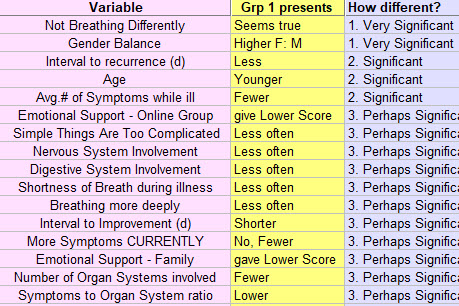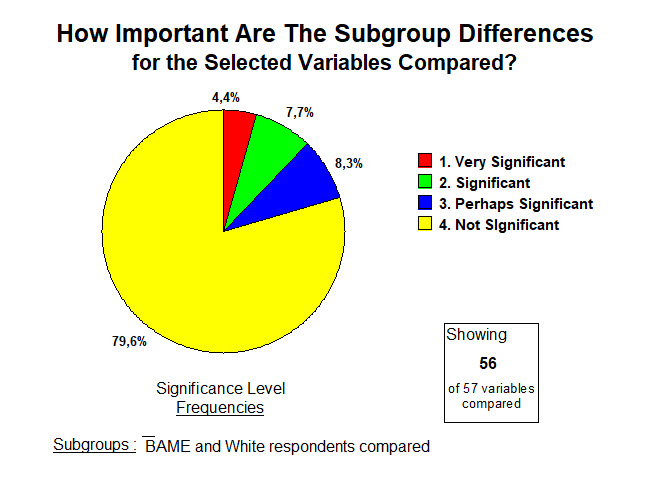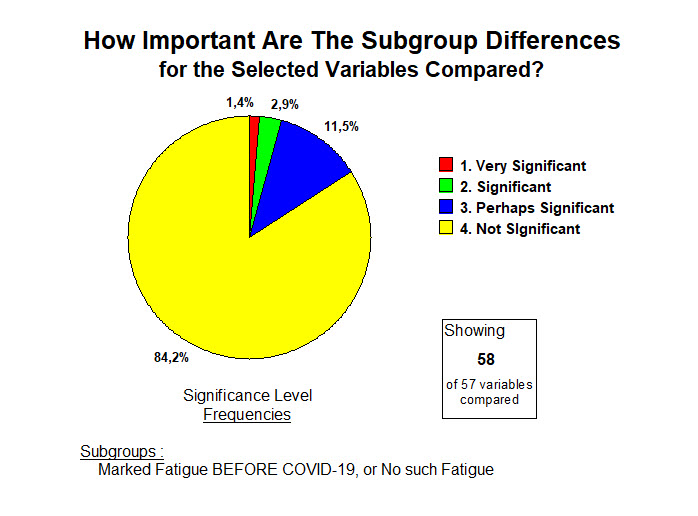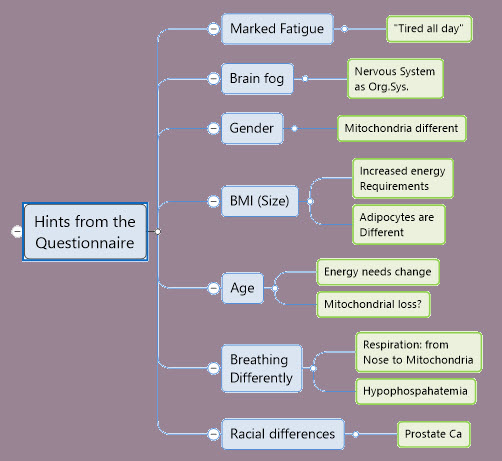Grouping Respondent Answers - Comparisons
LTCOVID.com
Thanks for visiting!
To translate this page, select your
language from the dropdown menu below:
"All Respondents" is of course the largest group.
The answers to the questionnaire and analyzed results for these first 136 participants have been presented.
Finding differences in the responses given, taking apart (and putting back together what was learned from the disassembly), is a traditional method for learning more.
What is the value of finding a difference that is "highly statistically significant" in a variable between two groups?
It helps us to see a difference where before we saw none. Sometimes these can be guessed ahead of time. But sometimes such a result leaves the investigatior stymied and incredulous. That's a good place to start from.
And if the topic relates to treating an illness, such a difference, once confirmed, may provide a window of opportunity in the pursuit of treatments and cures.
One must not forget that the negative result, finding no difference at all, and confirmed by tools that make it less likely that such a conclusion is actually a mistake, ... those results are very important as well. Perhaps less exciting than a 'new discovery' emerging from a previously unseen difference.
Finding that there is absolutely no difference in the rate of complications and side effects from administering a new vaccine to 2 different groups, is obviously important (and timely).
So lets do some comparing within our questionnaire's responses obtained.
A questionnaire of 59 questions.
And within those questions different possible choices of answers selected.
Age, gender, race, smoker or not, differences in body size, medications, physical and emotional status ...
Suddenly, a whole host of possible groupings, the "haves" and the "have nots" comes to mind.
Here's how we approached that.
Here's a larger view of the upper portion of the above ...
Each click on one of these selected buttons, provides the mean values for 57 variables in the group selected.
One sees 78 subgroups, each responding to 57 variables that come directly out of the survey's 59 questions (the last 2 were written responses, advice to patients and advice to medical teams, already presented).
So for example, did smokers (increased above the number found in the population), have more sympotms than non-smokers? What about their differences in age, in weight, or duration of illness?
All respondents, by answering, self-dentified as having "long-term" COVID-19.
There was no control group of healthy volunteers.
Let's look at several of these comparisons listed above.
Let's look for possibly different results arising in various groupings of :
-
-
- Gender
- Race
- Age
-
- Those are pretty usual headings or subgroupings. But what results will become more apparent, if the larger sample is divided into less usual groups? Such division is not random. It is suggested by the overall results.
-
- Those who had Marked Fatigue BEFORE becoming ill with the virus, compared with those who did not usually suffer fatigue. Vitally important to our journey towards a conclusion.
- Those who reported a number of symptoms 1 standard deviation ABOVE the mean (or average) number reported by all respondents, and 1 std. deviation BELOW that overall mean value.
-
Why pursue these last two?
-
-
- Fatigue is a frequent reported symptom to be found in the answers. But some respondents had this (and often other symptoms) BEFORE becoming ill. If they are still fatigued, why is that? "Same as usual," or someting new? Or something superimposed on the pre-existant fatigue, and worsening it?
- Symptoms abound in number in this group of patients. We learned and confirmed that. If one divides the respondents into a group with very many symptoms, and another with many fewer symtoms than most, ... What can be learned about how symptom number relates to the 56 other variables? Perhaps having more or fewer symptoms due to this viral illness would make no difference. That doesn't seem medically logical. While which symptoms a patient presents with is key to making a diagnosis. If the patient presents with few, the rest often need to be patiently ellicited. But at first pass here, we'll try to learn what the number of symptoms has to teach.
-
"Who says there's a difference?"
Many questionnaires aim at thousands of responses. Product marketing surveys come to mind.
What sells better? The blue or the yellow ice cube trays. Before having them manufactured, let's make just two and show them to 10 000 people and see which one they pick.
So if we have obtained at present, only 136 responses, is that enough? Enough to find important differences where they exist?
Fortunately, small group statistical methods come to the rescue. And without further pushing a proof of that hypothesis on you kind reader, we'll see below how use of such tools played out.
In what follows, results are sorted by those most statistically significant at the top, down to no differences found between subgroups, at the bottom.
GENDER DIFFERENCES
For these 57 variables compared, how important were the differences found in these between men and women?
The illness "behaved" similarly in men and women, 80% of the time. Yet women present with it much more often.
And for the 20% where statistical methods found a difference, for Men (Grp 1), where should one direct one's attention? (These below, taken from the top of the above list). And if these are mathematically different from the results for female respondents, are they clinically important? And to be pursued how?
The scond line below shows how naive the process can be. It confirms a very significantly greater number of Females than Males. We knew that. But clearly, that should not be too quickly dismissed.
Once we know a thing, we at times accept it too quickly as normal. As just the way it is.
But the above results seem to point towards a less severe "long-term" COVID-19 illness in men than for the women.
----------
AGE DIFFERENCES
Group 1 older than 50 years and Group 2, 50 or less.
For these 57 variables compared, how important were the differences found in these, between those older and younger?
Some increase in "important" findings for Age, when compared with effects of Gender differences.
Here is the "top of the list" for those who are older (Grp 1) and presenting with "long-term" COVID-19:
(Again, the significant age difference result is one we created, by grouping them into 2 groups).
A clear difference between these older respondents and the younger, is that they gained weight and were larger to begin with. They had been sick a little longer, and their illness began earlier.
Most of these differences are lower values than in the younger group.
But the strongest statement once again, seems to be that there were no significant differences in this illness based on a "cutoff" in age at 50 years. 76% of results are "No difference."
Of course, older members of the population who were perhaps sicker and hospitalized in an ICU, (our respondents mostly had a "moderate illness"), did not take this questionnaire at that time. That may not be important at all in defining this "long-term" variant of the COVID-19 illness as it is currently presenting in the majority.
Here is a link to The Severity of Illness question (#28) and its results. But the point is that for those with "long-term" COVID-19 who were older, and responded to our survey, age per se made less impact on severity of illness and outcomes. That too is telling us something about this variant of the COVID-19 illness.
--------------
DIFFERENCES LINKED TO RACE
Group 1 = BAME, (Black, Asian, minority-ethnic) & Group 2 = White/ Caucasian
For these 57 variables compared, how important were the differences found in these, between those BAME and Whites?
Once again, a distribution of frequencies of result significance that's starting to look familiar.
BAME (Grp 1) at the "significant" end of the spectrum for these variables, as below:
Some interesting findings emerge from the BAME respondents even if relatively few in number.
Again the "small group" tools let us make pronouncements with a bit more confidence.
Some differences observed remind us to mention that some of these differences found in variations in race or ethnicity, may precede this viral illness. They may nevertheless come along for the "L-t" COVID-19 journey.
For example, from above: more Digestive System involvement than in whites. A study of American Blacks had found 4 times higher incidence of Helicobacter pylori (bacterium associated with ulcer disease), than in whites.
One finds other lines above, that speak to the presence of more disease in the BAME respondents, and again, the medical literature supports this. It is too often overlooked. Though younger, these respondents have more symptoms, already before the illness and on the day responding to the survey. More organ systems involved. Less use of nutritional supplements.
We can also find a shorter interval before improvement of the illness. Also more hopefulness expressed when projecting Quality of Life one year from now. Perhaps the two are related.
These findings do not speak to the BAME population outside the "long-term" COVID-19 theatre.
Yet clearly, this ilness takes place in the setting of one's health before becoming infected with the virus.
----------
What do the grouped responses to the questionnaire tell us about fatigue, a fairly universal symptom in this group of respondents (and in the related literature)?
But some had this symptom BEFORE becoming ill with the virus. What difference might that make?
FATIGUE : BEFORE & NOT
Group 1 = Marked Fatigue BEFORE & Group 2 = No Marked Fatigue Before
In quickly scanning the bluish columns, one notices that most comparisons for these 57 variables, yield differences that are not significant.
Distribution of significance frequencies?
Pretty much as just suggested.
But there are some important differences ...
More Fatigue Before (Grp 1):
One gets a sense that whatever the Grp 1 respondents here brought to this illness from before its onset, those things did not help make this illness pass more easily. More symptoms per each organ system seems translated nevertheless into a response that is more emotional than physical compared with Grp 2. And to find help, this Grp 1 turns mostly to personal habits and practices.
Yet the majority finding is that for most of the 57 variables that were explored by the questionnaire, this fatigue present before or not, made little difference.
Yet where the differences appear in the list above, they may make a critical difference in outcome from this illness.
Imagine a conversation at the doctor's office.
The information just provided should contribute the facts for changing a patient's behavior.
"If you have (X, Y or Z - you can chose from the lists above) you are at increased risk for having this "long-term" variant of the COVID-19 illness, should you get it. Perhaps we can work on that, and decrease your risks for being ill for a long time."
Ahhh ... applied research.
------------
And finally ....
DIFFERENCES LINKED TO NUMBER OF SYMPTOMS
Group 1 = a number of reported symptoms that is 1 standard deviation ABOVE the mean, and
Group 2 = the numeber of reported symptoms is 1 standard deviation BELOW the mean or average number of symptoms during this illness. and "during" actually means: Early, During, Currently in the illness course.
Here is their long list :
One notices fewer comparisons of the 57 variables, that identified no differences than in the last comparison above, but those are still the majority.
More than a quarter of the 57 variables are pointed to as important to focus on and explain if possible.
More symptoms (Grp 1) means :
First of all, and perhaps surprising or not, a better performance on answering the questionnaire!
Well. We need more of these !
But more importantly, this longer list also equates with pretty rough sledding generally for those in this group.
One doesn't always need to have a huge number of symptoms to be quite ill.
For example, a 68 year old male who presents with one symptom: crushing substernal chest pain,
may already have all the symptoms he can handle.
But this result is simply confirming that more symptoms seem to clearly take a toll on the patient.
Above is essentially a description of a rather widespread disease.
And another point. Simply making up a long symptom list "for effect" when comunicating it, probably would not fit so well with the 28 variables brought together here.
Physicians tend to not like lists of patient problems that feature lots of symptoms.
Here, this above average number of symptoms group is probably relaying things as they are.
That risks proving to be a bad matchup of patient and provider.
Even worse, patients in this group 1 s.d. above the mean number of symptoms, have a picture of significant diffuse involvement working against them.
Perhaps their higher score on the questionnaire than that of those with many fewer symptoms, reflects a
a clear and straightforward message that needs to be heard.
----------
IN SUMMARY
Here are the results if one puts these 5 groups (or 10 subgroups) back together again ...
That provides 285 opportunities for comparison.
Looks very similar, doesn't it.
So the point remains that a unified view of the effect of this illness is indicated:
BAME and white, older and younger, men as well as women, more symptoms or fewer, fatigue starting before or not, ... are all in the same boat 79% of the time.
That does not mean they're enjoying the cruise.
Many have been in that lifeboat for 7 months now, ... awating rescue while pulling at the oars from time to time with what energy is left. A Medical 'Raft of the Medusa'.
Sometimes searching for differences leads to a bias. As though the conclusion becomes, and not at all supported as we saw, that these respondents are all different. That each is individually living an illness different from their "long-term" COVID-19 neighbor. Well they are not.
Having said that, if we put all these 10 paired subgroups back together, what happens at the top of that list sorted by signficance ?
Here we've limited the discussion to SIgnificance Level 1, Very Significant differences.
We've also added on the left a column with the "Comparison Name."
The position at the top of this list of the "1. Very Significant" seems have been taken over primarily by two groups: those with many more symptoms, and the BAME group.
So looking for and finding these differences through such comparisons can in fact shed light as well as heat. ("Heat" in this case, is moving around and ahead at times, but without much progress. "Light" is, well we'll see here in just a bit ).
-----------
POST SCRIPTUM
Before moving on, one more point to emphasize.
Shown below, data from the 5 groups just discussed. Representing 285 comparisons of variables pertinent to the "long-term" COVID-19 illness.
Before splitting these into their groups (here reassembled), how close to normal were the results for these variables overall?
Imagine looking at your lab report from your last blood test. Unless you're in the midst of a health catastrophe, maybe some results a bit above those in the laboratory normal values column, and maybe some a bit below.
But often reassuring.
That is not the case here.
Essentially 75% of these variables have results that are markedly abnormal, varying to at least "a bit unusual."
So before getting lost in subtle statistical differences, one should interpret this overall result as being in the category of a health catastrophe in the making. Already well settled into place in fact, but continuing.
To view it otherwise is to place oneself seriously behind the "8"-ball in this game. And the virus knows its way pretty well around the table.
The advice given by respondents to healthcare providers is in general, good advice.
Some find the phrases there hard to swallow and start getting defensive. Not the right response.
Time to get a move on.
Time to think out of the box.
And no, it's not a game.
And no, the "long-haulers" are not all just a bit loony.
Then again, if you had it, you might just get a bit loony yourself.
-----------
At the top of this page I informed that the questionnaire's answers had generated 78 groups, each eager to present its results for the 57 variables of the questionnaire.
Here we've presented 5 of these 78 groups: age, race, gender, fatigue before, and many symptoms.
On a separate page, I have added a similar analysis of smokers vs. non-smokers.
And on another, a comparative analysis of Normal Body Size (BMI) vs. Abnormal. And the effects.
We'll let the other 71 groups quietly rest for now, and move on to other tasks, some waiting much less patiently.
----------
And here's a teaser !
----------
Here responses were used to generate comparisons, finding differences that add to our understanding.
It is also possible to put together different questions & responses to see what emerges.
Here's one example:
Respiratory Alkalosis and Hypophosphatemia >>>>>
<<<<<<< Home
A découvrir aussi
- Comparing Smokers & Non-Smokers with "Long-term" COVID-19
- A Comparison: Differences in "long-term" COVID-19 linked to Body Size





















